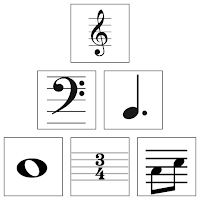Building Blocks: The Chromatic Scale
In this lesson we will learn about the Chromatic scale. The chromatic scale is simply all the notes we use in the western system of music. We already learned about the notes in the musical alphabet and that they are simply the white keys of a piano keyboard:
What we haven't learned yet is the names of the notes in between the letters in the musical alphabet. These are the notes on the black keys of a piano keyboard, or the notes that are between all of the letters that are a whole-step apart.
Remember the half-steps in the musical alphabet? Sure you do, because there are only two: between B and C, and between E and F. Now remember what we learned about sharps and flats? a sharp raises a note by one half-step, while a flat lowers a note by one half-step. So let's add a sharp to the note A. This moves it up one half-step to the black key. Have a look:
So you see, by adding a sharp to the plain letter name the note is moved up to the adjacent key on the keyboard. This works the same way with all of the notes. Now let's see what happens when we add a flat to the note A:
By adding a flat to the plain letter name, the note is moved down to the adjacent key on the keyboard.
So, if we add a sharp to the plain letter name, it moves up to the adjacent key on the keyboard, and if we add a flat it moves down to the adjacent key on the keyboard. Let's take the note B and move it down by adding a flat to it:
Now wait a minute, isn't that key supposed to be A#?! It was A# when we added a sharp to the A, however now it's actually Bb because we added a flat to the B. This is probably the single most confusing thing for most people at this point in the learning process. That note in between A and B can be either A# or Bb, it just depends on the context. Yes it's the same key on the keyboard, and it sounds the same no matter what you call it, but the name (or "spelling") changes depending on how it's used. It's exactly like the words "to", "too", and "two" in the English language. They sound the same, but context determines which one we use. This will make more sense later when we actually have a need to use different spellings.
So now that we know how that works, let's write out all the notes. I will show them to you using all sharps, and again using all flats.
A A# B C C# D D# E F F# G G# A
A Bb B C Db D Eb E F Gb G Ab A
This is the Chromatic Scale. As you can see, A# is in the same place as Bb because they share the same key on the keyboard as we saw in the last example. The same is true for C# and Db, D# and Eb, etc. You'll notice there is no note between B and C or between E and F, because those are only a half-step apart, remember? There is no black key between either of those pairs of notes.
There is a specific word we use for different notes that share the same key on a keyboard, and that word is enharmonic. We can say that A# is enharmonic to Bb, or that D# is enharmonic to Eb. Remember, the exact spelling of a note depends on the context, and this will make more sense later, I promise.
Remember back when I said sharps and flats can be applied to any note? Well let's see what happens when we add a flat to the note C:
"But that's B!" you yell at me. Well right now it's Cb, since we added a flat to the C. It may sound the same as B, but remember it all depends on context. The spelling of notes matters, just like using the correct version of "there", "their", or "they're". Once again, this is an example of enharmonics. I know this concept is probably confusing right now, but just keep it in the back of your mind going forward. We'll come back to it. In the next lesson we will take a deeper look at the Major Scale.
If you have any questions post them in the comments below.






Comments
Post a Comment
Feel free to ask questions or start a discussion, or leave a suggestion for future articles! Please keep it civil.